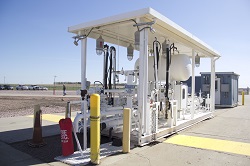Caterpillar and First Solar, Inc. have announced a joint partnership to develop an integrated photovoltaic (PV) solar solution for microgrid applications. First Solar will design and manufacture a pre-engineered turnkey package for use in remote microgrid applications, such as for small communities. The package will feature Cat-branded solar panels manufactured by First Solar and will include a balance of system components.
“This strategic alliance provides yet more evidence of a global energy transition, where solar energy’s reliability and cost competitiveness with traditional fuels effectively allows it to complement conventional generation. It is also  evidence of the role that solar can play in enabling the local generation and distribution of energy to address specific needs,” said Marc van Gerven, First Solar’s vice president for Global Marketing. “By entering into this alliance with Caterpillar, with its extensive experience and reach, we’re establishing an important new precedent for the commercialization and scaling of microgrid-based distributed generation solutions.”
evidence of the role that solar can play in enabling the local generation and distribution of energy to address specific needs,” said Marc van Gerven, First Solar’s vice president for Global Marketing. “By entering into this alliance with Caterpillar, with its extensive experience and reach, we’re establishing an important new precedent for the commercialization and scaling of microgrid-based distributed generation solutions.”
Caterpillar will exclusively sell and support the integrated solution featuring Cat-branded solar panels through its worldwide Cat dealer network, along with its current offerings of generator sets and energy storage. As noted by Caterpillar, microgrids provide value to prime power diesel and gas customers by integrating renewable energy, such as solar power, with generator sets. This technology can help to provide reliable, affordable clean energy.
“We are excited to announce this alliance, underpinned by First Solar’s 10 gigawatts of global experience in solar energy, and coupled with Caterpillar’s knowledge of generator sets and distributed power, and the strength of our unmatched dealer network,” said Steve Niehaus, Caterpillar vice president with responsibility for the Electric Power Division. “By working with First Solar, we will optimize the efficiency and integration of solar power with our offerings.”
Caterpillar expects to first market the new microgrid solution in the Asia Pacific, Africa, and Latin America regions, with the integrated PV solution, including Cat-branded solar panels, available for customers in that region in the second half of 2015.








